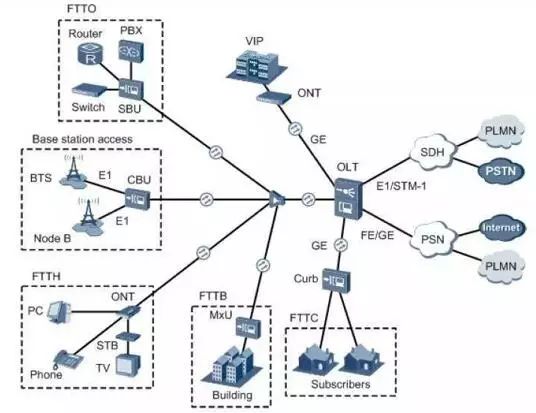With the development of modern cities towards multi-functionalization, the urban layout is becoming more and more complex, and there are hundreds, hundreds, or even thousands of ground monitoring points. To ensure that functional departments can grasp real-time, clear and high-quality video images as soon as possible, Highlight the tension of fiber optic resources. Moreover, in today’s increasingly powerful and complex urban functions, re-laying fiber-optic cables is not only very costly, but coordination among all parties is even more difficult. In view of this, how to solve the above problems?
In fact, the same problem was encountered in the construction of FTTH (Fiber to the Home) by telecommunication operators. In order to solve this problem, give full play to the bandwidth advantages of optical fiber, solve the shortage of optical fiber resources, and improve the reliability of the network, telecommunications operators have chosen PON (passive optical network) technology. This technology can also be applied to security network monitoring.
PON (PassiveOpticalNetwork) is a passive optical network. A passive optical network includes an optical line terminal (OLT) installed in a central control station, and a set of matching optical network units (ONU) installed in a user’s premises. The optical distribution network (ODN) between the OLT and the ONU contains optical fibers and passive optical splitters or couplers.
The passive optical network does not have any active devices from the center to the resident network. Instead, the passive optical devices are inserted into the network and the transmitted traffic is guided by separating the power of the optical wavelength along the entire path. This replacement eliminates the need for users to supply and maintain active devices in the transmission loop, which greatly saves user costs. Passive optical splitters and couplers only play the role of transmitting and limiting light, do not need power supply and information processing, and have an unrestricted mean time between failures, which can reduce maintenance costs in an all-round way.
The advantages of PON technology are mainly reflected in the following aspects:
1. Optical fiber access network is the most suitable solution for future development, especially PON technology has been proven to be a very cost-effective way in current integrated broadband access.
2. Due to the use of PON technology, the entire optical distribution network is passive, and the passive optical network is small in size and simple in equipment. Compared with copper cable networks, PON can reduce maintenance and operation costs, and completely avoid electromagnetic interference and lightning interference.
3. The passive ONU (optical network unit) of the PON does not need power supply, which not only eliminates a series of problems of power supply, but also has better reliability than active equipment.
4. Because the passive components are used and the optical fiber transmission medium is shared, the investment cost of the entire optical network is low.
5. PON is transparent to the transmission system used to a certain extent, and it is easier to upgrade.
PON technology has become the industry’s first choice for fiber-to-the-home (FTTH). PON technology uses a point-to-multipoint topology, and downlink and uplink transmit data through TDM and TDMA respectively. The distance between the OLT and the ONU can be up to 20km, the transmission rate is bidirectional symmetrical 1Gbps, and the maximum splitting ratio generally supports 1:32 or higher. It can be split in one level or multiple splitters in cascade.
The use of PON technology can effectively solve the network monitoring bandwidth and distance limitations. The OLT equipment at the office side is deployed in the office room at the office side. Multi-level optical splitting is used to realize flexible deployment of points. The ONU + network camera is used as the terminal combination. The ONU can be a PoE switch with PON function. To the customer’s monitoring room and storage server. It can be monitored in the monitoring room in real time, and the video data is sent to the storage server at the same time, which facilitates the collection of evidence after the fact.
Today, “optical advancement and copper withdrawal”, the widespread application of PON technology is particularly important. Fengrunda launched OLT and ONU equipment, as well as supporting PON security solutions, and firstly launched a PoE switch with PON function, which made up for the gap of ONU without PoE in the current market. The remote video monitoring system using PON technology reasonably solves the problems of dense and complex monitoring points and tight fiber resources in modern cities. It has unparalleled advantages in many aspects such as network configuration, fiber resources, video quality, and reliability. The development of commercial remote video surveillance services provides the best network solutions.







